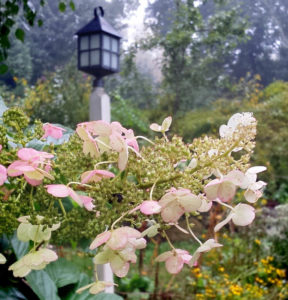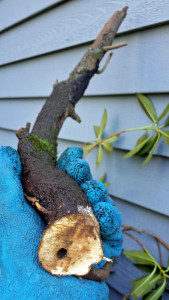Tag Archives: pruning
Shrubs to Prune in Late Winter – Which Ones and How?

The hydrid Kordesii Rose John Davis is a hard-working rose that blooms periodically from June to September on new wood. Prune it in late winter for the strongest show all season.
Late winter to early spring is a terrific time for pruning many shrubs. What should you prune and when? You could study pruning for an entire semester, but here are some basic guidelines. I recommend that you properly identify, then research, each particular kind of woody plant before you consider your first cut:
- Safety first 1) If any part of a tree or shrub is within ten feet of any kind of electric cable or wire, stop and call a professional. 2) Wear gloves and sturdy shoes, and use only sharp tools like bypass (not anvil) hand pruners and loppers, and saws. 3) Sanitize your tools and gloves with isopropyl alcohol or a product like Lysol spray before you start, and again when you’re done pruning each individual plant.
- General concepts Notice the overall shape of the shrub. Most flowering shrubs should be balanced and open in their center. Start pruning by removing all dead and diseased branches, then look for branches that cross or touch each other. Rubbing branches damage the bark tissue, inviting pathogens and pests, so remove one or both branches, depending on their condition, all the way to the base. Branches that grow from the perimeter towards the center should usually be removed. To shorten a branch or twig, cut it 1/4 inch above an outward-facing bud so new growth heads towards the perimeter of the shrub.
- When does your shrub bloom? 1) For spring bloomers, pruning them during the late dormant period (late winter/early spring) will remove flower buds, which were formed last year after the shrub bloomed. No flower buds, no flowers, so wait until after they bloom this year. 2) For later bloomers, pruning them now, before they form this year’s flower buds, is ideal. These can also be pruned soon after blooming.
- Roses Relax. Roses are simply shrubs that benefit from annual pruning. Prune in late winter to early spring (late dormancy) or when the buds start to swell. First cut out dead, broken, diseased and crossing canes. Put all your pruning debris in a trash bag and throw it away. Do not compost. Fertilize your roses with something like Espoma Rose-Tone or a good organic slow release fertilizer by following the directions on the bag. Climbers like to keep their main stems, so keep them fresh by pruning their lateral branches. Once the main stems are three years old, consider cutting one or two of them to their base to encourage new ones. Then cut one or two of the oldest every year. For shrub roses, cut up to 1/3 of the canes, the oldest, thickest woody ones, to their base as you open up the overall look to a vase shape. Cut to their base any super skinny canes from last year. For height, cut the remaining canes to about 1/2 their height, 1/4 inch above a robust outward-facing bud.
Please feel free to contact Carol with any questions.
WHY YOUR HYDRANGEAS DIDN’T BLOOM THIS YEAR

Why didn’t your hydrangeas bloom this year? Most likely they were either pruned at the wrong time of year or their flower buds were damaged by winter weather or foraging deer. This panicle hydrangea, recognized by it’s cone-shaped flower head, is in a Sharon, MA garden. still blooming in early October.
Why didn’t your hydrangeas bloom this year? Most likely they were either pruned at the wrong time of year or their flower buds were damaged by winter weather or foraging deer.
With so many species and numerous cultivars, hydrangeas confuse many gardeners and even landscape designers when it comes to understanding the best time of year for pruning. Many gardeners prune at exactly the wrong time, eliminating almost all flower buds for the entire season.
Most early blooming shrubs, including some hydrangeas, develop their flower buds during the summer and fall of the previous year. This is known as blooming on old wood. Other hydrangeas develop their flower buds in the spring every year, then bloom later in the season. This is called blooming on new wood. Hydrangea cultivars such as Endless Summer™ bloom on both old and new wood.
Panicle hydrangea (Hydrangea paniculata) and smooth hydrangea (Hydrangea arborescens) develop their flower buds on new stems (new wood). Therefore they can be pruned back severely in the late fall or early spring to manage their size, and they will still provide flowers. Even after exceptionally cold winters where stems are killed to the ground, new spring stems will produce flowers. In our climate and soils, panicle hydrangea and smooth hydrangea are typically the easiest species to grow and provide the best show. Panicle hydrangeas, for instance, can bloom from July through October.
Common panicle hydrangea cultivars include: Limelight’, Vanilla Strawberry, Little Quick Fire, ‘Grandiflora’ aka PeeGee, ‘Fire and Ice’, Bobo®, ‘Bombshell’, ‘Little Lamb’, Quick Fire®, ‘Pee Wee’; Pinky Winky®, ‘Praecox’, and ‘Tardiva’. You can recognize them by their cone-shaped flower heads.
Common smooth hydrangea cultivars include: ‘Annabelle’, Invincibelle Spirit®, Incrediball®, and ‘Grandiflora’.
By contrast, hydrangeas that bloom in the spring bloom predominantly on old wood from flower buds that were formed during the previous summer and fall. They include bigleaf hydrangea (Hydrangea macrophylla), oakleaf hydrangea (Hydrangea quercifolia), mountain hydrangea (Hydrangea serrata) and climbing hydrangea (Hydrangea anomala subsp. petiolaris). These varieties should be pruned immediately after the flowers start to fade. You can cut off the just the flowers or cut the stem at any point you need to in order to control the size and shape of the shrub. If you prune later in the year, you’ll be removing next year’s flower buds.
If you know the type of hydrangea you have in your garden, it can take some of the mystery out of understanding why they’re not blooming as you expected, and knowing when to prune them. If you do not know what type of hydrangea you have, do not prune them. Remove only the dead wood in spring, then wait until they bloom to determine when to prune them the following year. If they’re planted in a favorable position in your landscape, they’re well worth waiting for.
Why Are My Rhododendron Branches Dying?

Cross-section of a rhododendron branch with a hole in it. A Rhododendron borer has tunneled all the way through this branch, and the branch is dead.
Could it be rhododendron borers? I started spring pruning for an organic gardening client in Sharon last week, on one of those yummy sunny 60 degree March days. Near her front door are broadleaf evergreen shrub beds on either side of an elegant entry path. My goals were to prune out any dead, use selective pruning to open up dense areas and stimulate new growth for a more balanced and pleasing form of individual shrubs and their big picture impact, and scout for pests.
A dead branch on a rhododendron caught my eye. I’m always very curious about why plants and their parts fail to thrive, so I investigated a bit. I cut off a portion of the dead branch and in its cross section found a dead giveaway of a clue.
It looked like an electric drill had made a 3/16 to 1/4 inch diameter hole in the interior of the stem, parallel to the length of the stem, and I knew right away it was quite likely the work of a rhododendron borer. I kept cutting the branch closer and closer to the ground, and found that the borer hole went all the way down to where the stem met the root flare at soil level. It may be that a second year borer spent some time in the roots, then bored its way toward the tip of this branch, contributing to its demise. I’ll continue to watch carefully for signs of activity and damage, and remember that borers are just one of several flavors of rhododendron pests.

This dead rhododendron branch shows a tunnel entrance created by a rhododendron borer in Sharon, MA.
How do you treat something like borers? Try the following methods, or contact me when you see damage and you need help gathering evidence and deciding how or whether to save your valued shrubs and trees.
Treatment for Rhododendron borers:
- Look around for dead branches and cut a cross section of one. Look for other signs such as a borer’s exit hole through the branch, frass (insect poop that resembles sawdust), and the condition of the leaves and stems. Photography these signs for your records.
- Be sure to properly identify the pest that is doing the damage. FYI there’s a separate and distinct Rhododendron stem borer
- Cut out and destroy all affected tissue – or save a sample to send to a lab.
- Whether there’s an effective pesticide for the two types of Rhododendron borers seems to depend on what extension service or licensed pesticide professional you ask, and in any case monitoring and prevention are the best next steps. This is an organic client who prefers organic treatments for the health of her family and the environment. An injection of nematodes into the stems may be appropriate if she has the stem borer. I’m looking into it.
Tips to help reduce borers:
- Keep mulch at least 2-3 inches away from the base of of all plants where the stems meet the earth, including rhododendrons. Your mulch should never be more that 3 inches deep.
- Keep shrubs well watered during dry periods. One inch of water per week is generally sufficient for established, healthy plants. More water than this is usually needed for plant establishment.
- Avoid wounding shrubs, as wounds can make it easier for insects and pathogens to enter. If your plants have any branches that directly cross one other, they probably rub against each other when it’s windy, causing abrasion damage and creating entry points for pests and pathogens. Also, do not wound shrubs with lawn mowers and string trimmers.
- If you don’t have an edged bed around a tree or shrub, make one large enough so that not only will your string trimmer no longer nick the trunk, but the mower won’t run over the root zone. A general guide is to edge out a bed that goes all the way to the drip line, defined as the area all the way from the trunk to the outermost circumference of the tree’s canopy . After cutting out and removing any lawn or weeds, etc. from your edged area, apply 2-3 inches of mulch to the bare soil.
Not all damage to rhododendrons is from borers. There are plenty more causes as well. So be careful, don’t jump to conclusions, get a positive ID, and get help if you’re not sure.
CONTACT ME IF YOU NEED A HAND
IF YOU’D LIKE ME TO HAVE A LOOK AT DAMAGED OR DISEASED PLANTS WITH YOU, I’LL PUT ON MY HORTICULTURIST HAT, HAVE A LOOK AND SUGGEST WHAT YOUR BEST NEXT STEPS MAY BE. CLICK HERE TO CONTACT ME
